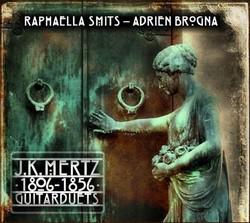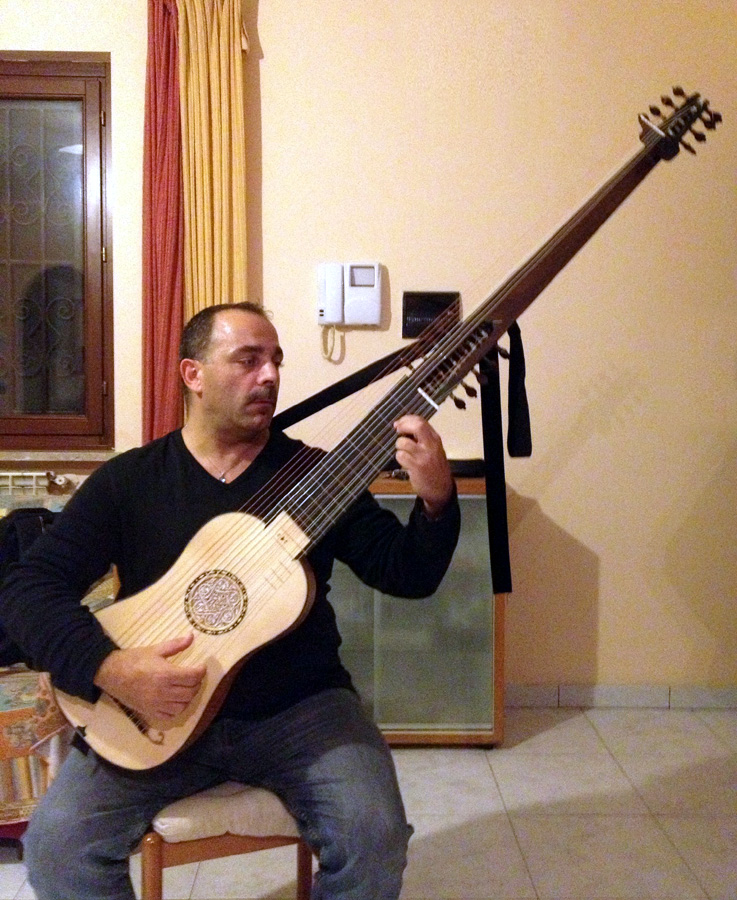My last major blog caught us up (more or less) on new contemporary harp guitar players, luthiers and music.
Today’s blog focuses on the past, although today’s “historical music” practitioners occasionally include a modern twist!
The current group falls into these general categories (from my own interpretations, not necessarily theirs):
•“Early Romantic Guitar” period instruments and music (on historically correct or modern instruments).
• Modern theorboed guitars on which lute music is typically played.
• Interpretations of historical theorboed guitars on which their specific music and/or other music is played.
Some of these folks have been around for a while now, some of these finds are very new, but nearly all are new to this site. I hope you’ll check out their activities, and I hope those I haven’t spoken with will share the same!
BTW, note that none of these practitioners refer to their instruments as “harp guitars” (nor need to, in normal context).
Starting at the top, new floating string activities in the E.R.G. world include:


Exciting news from last year, when all-around early music plucked string virtuoso Hideki Yamaya joined fellow multi-string guitarist/lutenist John Schneiderman (no stranger to Harpguitars.net readers) to release a ground-breaking double CD of the never-published guitar manuscripts of Adam Darr (1811-1866). These include duets for terz, standard, open-D and “bass” guitar. Hideki played a 10-string harp guitar on six pieces.
Great album, and glad they used an HG on the cover (though I’m still curious why they only showed one instrument on the cover of a guitar duet CD…).

 Duo Raphaella Smits-Adrien Brogna
Duo Raphaella Smits-Adrien Brogna
Raphaella has been on Harpguitars.net from the beginning, being a devoted player of the 8-string (2 floating basses) guitar for some time.
She has recently partnered with Adrien Brogna, who also plays a 2010 Bernhard Kresse 8-string,and the duo has just released their first CD: “J.K. Mertz, 1806-1856:Guitar Duets,” utilizing 8-string guitars and terz guitars.

Another new CD just came out (in Italy) from New Jersey 10-string classical guitarist Stanley Alexandrowicz. He is the first harp guitarist to record the works of the Croatian virtuoso 10-string composer-guitarist Ivan Padovec, which should be pretty interesting! With soprano Dominika Zamara, the recording features Padovec’s complete songs in the Croatian language and two of his big solo 10-string guitar works.
Interestingly, Stanley has both an historically correct 1861 Scherzer copy (with Dubez-style cutaway) made by Gary Southwell as well as a custom 10-string version of Gary’s contemporary A-series. Stanley exclaims that “it is MAGICAL! He used the 6,000 year old Bog Oak wood, and the top derives from the supply Julian Bream purchased with David Rubio years ago (and which Gary obtained).”
Here are photos of Gary and Stanley in Gary’s Nottingham shop on pickup day:


And both of Stanley’s together:

There is undoubtedly much more happening on 8- to 10-string historical guitar, as those I’ve written about in the past continue their careers.
Next! Lute music on new theorboed guitar designs

Mark Anthony McGrath has had some lovely YouTube videos up for a couple years now, playing a “13-string guitar” (harp guitar, in this case) he developed with Cork luthier Harry McCormick to “emulate characteristics of the baroque lute.” Mark’s new album “The Weiss Machine,” which was released in June 2015 features 18 tracks of the lute music of Sylvius Leopold Weiss (1687-1750) performed on this instrument.

Luthier Michael Thames’ modern theorboed “Dresden guitar” has been in my Form 1a Gallery for many years, but I only recently found him playing a newly completed instrument (beautifully). Here, it is tuned to D minor baroque lute tuning to play Weiss’ “Prelude in D minor.”
Historical(ish) Theorboed Guitars
I am absolutely thrilled by the number of Early Music and Baroque guitarists who have decided to explore the world of the earliest theorboed guitars – specifically those from the mid 1600’s to late 1700’s. I’m constantly asked “What is the oldest harp guitar?” and the answer has proven so elusive that I’ve yet to create an article on this important topic.
While the instruments themselves remain extremely mysterious, two small collections of music are not. And recently, not only has some serious attention been given to these manuscripts (most notably by Monica Hall), but players (and their creative accommodating builders) are finally starting to give voice to this music: the earliest known “harp guitar music.”

The most recent is Spaniard Thomas Schmitt, who had Carlos Gass build him this instrument last year:
It is a “best guess” practical reconstruction of an instrument shown in an engraving that may depict the Italian “chitarra atiorbata,” for which one Giovanni Battista Granata wrote five pieces in 1659. The five fingerboard courses were tuned as a standard 5-course Baroque guitar (octaves on the 4th and 5th courses), with the seven diapasons descending diatonically from G down to A.
Thomas recently posted two videos playing this unique instrument. In the first, he plays one of the Granata pieces; the second is a piece by Gallot, written in the following decade for the possibly-similar French “guitare theorbee” – of which no evidence exists beyond the fact that the instrument was tuned in C major/minor.
I would love for Thomas to produce a recording of this music – let’s all pester him until he does!
Unbeknownst to me, another player and builder collaborated on a similar project (above). This is an “own design” interpretation of the Granata instrument built in 2010 by Christopher Davies of Portland, Oregon for Hideki Yamaya, whom you met above from the Darr project. Asking Hideki about it, he replied:
“Alas, the theorboed guitar has been sold… I needed funds, and it was the instrument that got the least amount of use. To be honest, Christopher built it (while I consulted) as an experiment, but it was kind of an awkward instrument: a little too ringy and deep for a lot of strumming, and not enough bass to replace a theorbo. But it was fun, and I did play it in a concert: some pieces by Granata and (lutenist) Losy. He’s not averse to trying another one!”
I, for one, am hoping the team revisits this!

OK, now we’re talking theorboed guitar!
This is Maurizio Scavone of Rome, who is playing his five foot long “chitara tiorbata” built by local luthier Carlo Cecconi. Maurizio is studying the same music – Granata and Gallot, along with a manuscript of a Neapolitan court dance (this reference was new to me).
This spectacular instrument is based – upon even more scant clues – on an instrument by Stradivari. Wait a minute – Stradivarius made harp guitars?! Yes, as I said, I have a major article to write someday… (Actually, Monica Hall has already written it, but I hope to make it all a bit more accessible to laypeople.) This instrument (or possibly, instruments) hails from a bit later in the early 1700’s.
 Was it – or perhaps one of the earlier instruments – the inspiration for those late 1700’s theorboed guitars in the French museums? No one yet knows. I’ve had up in my Form 1a Gallery for many years a nice reproduction by Brazilian luthier Luciano Faria (I always wanted to order one from him…).
Was it – or perhaps one of the earlier instruments – the inspiration for those late 1700’s theorboed guitars in the French museums? No one yet knows. I’ve had up in my Form 1a Gallery for many years a nice reproduction by Brazilian luthier Luciano Faria (I always wanted to order one from him…).
But I only just recently discovered one of Luciano’s instruments in the hands of an original customer – Felippe Maravalhas, of Brazil, who commissioned the first one (I believe) back in 2004. He’s been performing on it ever since, in various settings and ensembles, including Ensemble Sonare. I haven’t yet contacted Felippe (nor heard from Luciano in many years). Note that this instrument has six strings on the neck, as does the Paris c.1780 instrument (originally listed as “c.1760,” the museum has since move back its circa date). However, Benoit Meulle-Stef long ago pointed out what appears to be a later alteration of that instrument from five single neck strings to six. An intriguing instrument (and period for the guitar), for sure!
Other luthiers have explored some of the other mystery instruments with apparent guitar tuning but lute bodies (or bodies and features as yet unknown). I hope to go into all this convoluted “Hidden Harp Guitar History” at a future date. Amazing stuff!









thanks Gregg, wonderful instruments…will look up these guys on U tube!